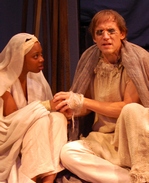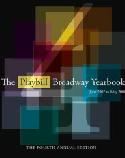SITE GUIDE
SEARCH
REVIEWS
REVIEW ARCHIVES
ADVERTISING AT CURTAINUP
FEATURES
NEWS
Etcetera and
Short Term Listings
LISTINGS
Broadway
Off-Broadway
NYC Restaurants
BOOKS and CDs
OTHER PLACES
Berkshires
London
California
New Jersey
Philadelphia
Elsewhere
QUOTES
TKTS
PLAYWRIGHTS' ALBUMS
LETTERS TO EDITOR
FILM
LINKS
MISCELLANEOUS
Free Updates
Masthead
A CurtainUp Review
The Oedipus Cycle
|
I will dispel this pollution, not on behalf of a distant friend, but for myself.—Oedipus
|

Susan Heyward & TJ Edwards in The Oedipus Cycle.
(Photo: Bob Johnson)
|
The Oedipus Cycle is masterfully helmed by the company's artistic director Shepard Sobel and uses an elegant translation by Peter Constantine. Harry Feiner has designed a simple but powerful set consisting of vertical poles stretching from floor to ceiling and strategically places around the stage to indicate a public meeting place. A change in the backdrop signifies the move from Thebes in Oedipus the King to Athens in Oedipus at Colonus and back to Thebes in Antigone. The three plays chronicle the tragic lives of Oedipus and his family, from the terrible discovery of Oedipus' crimes of incest and murder to the death of his daughter, Antigone.
Oedipus the King deals exclusively with the young monarch who has brought disaster down on Thebes. Oedipus at Colonus relates how the banished and elderly Oedipus, with Antigone as his guide, seeks refuge in Athens and refuses to return to Thebes despite the importunities of his relatives, who want him back for their own selfish reasons. Antigone is the tragic figure in the final play. Her loyalty to her brother, Polynices, and her devotion to the will of the gods compels her to bury her brother in defiance of her uncle, Creon, who has decreed that Polynices, who invaded Thebes, is a criminal whose body should be left for the animals to devour.
By presenting all three plays in one night, the Pearl makes absolutely clear the unity and complexity of Greek thought: the role of fate, the dignity of life, the inherent tragedy in human existence. The massive effort obviously required a considerable amount of cutting, in this case made so subtly and effectively the production seems more forceful than diminished.
In some cases, actors play the same role throughout. John Livingston Rolle is the stalwart Creon. Other actors play two major parts. Jolly Abraham lends her considerable talents first to the role of Jocasta and then to that of Antigone. TJ Edwards is excellent as both the bitter, disillusioned Oedipus in Oedipus at Colonus and the cowardly and very funny guard in Antigone.
The Oedipus Cycle is so well staged that the action has a choreographed quality entirely in keeping with the gravity of the situations and the dignity of the characters. One can easily imagine ancient audiences that knew the stories well deeply engaged in the destinies of these tragic heroes, with all the religious and philosophical implications of their awful fate.
As theater has developed over the centuries, we have come to forget its religious and ceremonial beginnings. The Pearl's presentation of the entire Oedipus Cycle reminds us that theater is much more than entertainment. At its very best it puts us in touch with ourselves at our most human and our most divine.
|
The Oedipus Cycle By Sophocles Translated by Peter Constantine Directed by Shepard Sobel Cast: Jolly Abraham, Dominc Cuskern, TJ Edwards, Susan Heyward, Jack Moran, Joel Richards, John Livingston Rolle, Jay Stratton Scenic Design: Harry Feiner Costume Design: Devon Painter Lighting Design: Stephen Petrilli Sound Design: M.L. Dogg Dramaturge: Kate Farrington Running Time: 3 hours, 5 minutes, two intermissions The Pearl Theatre Company, 80 St. Mark's Place at First Avenue, 212-598-9802 From 10/14/08; opening 10/27/08; closing 11/16/08 Tuesday at 7PM; Wednesday at 2PM; Thursday, Friday, and Saturday at 8PM; Saturday and Sunday at 2PM Tickets: $45-$55 Reviewed by Paulanne Simmons Nov. 1, 2008 |
|
REVIEW FEEDBACK Highlight one of the responses below and click "copy" or"CTRL+C"
Paste the highlighted text into the subject line (CTRL+ V): Feel free to add detailed comments in the body of the email. |






